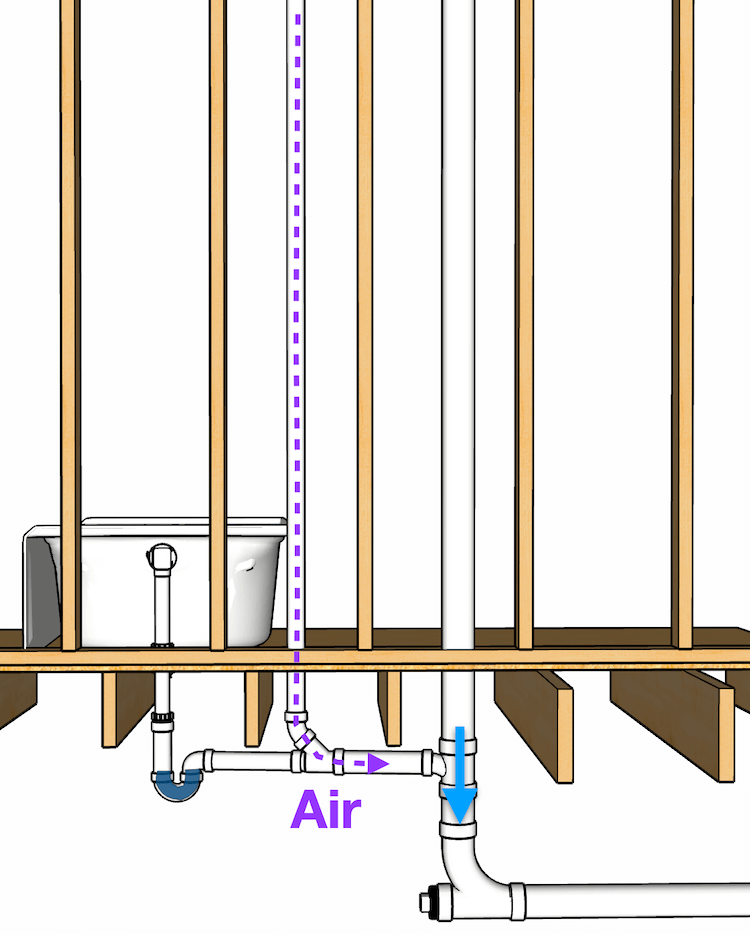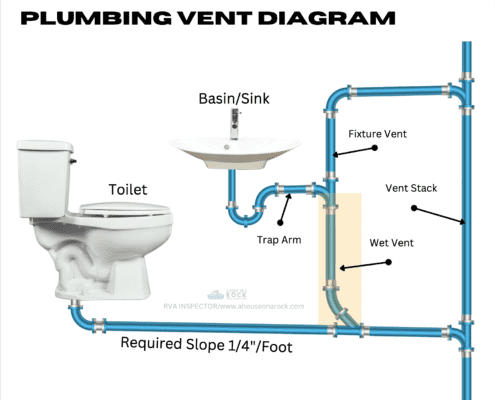Just how do you really feel when it comes to What Is A Plumbing Vent & How Do They Work??

Appropriate air flow in plumbing systems is often forgotten, yet it is vital for preserving the capability and security of your home's plumbing. Ventilation aids control air pressure, avoid the build-up of hazardous gases, and ensure the reliable elimination of waste. In this guide, we will discover the relevance of proper pipes air flow, just how it functions, and the benefits it gives your plumbing system.
How Air Flow Works in Plumbing Equipments
Air Pressure Law
Appropriate air flow preserves well balanced air pressure within the pipes system. When water moves with pipelines, it displaces air. Without sufficient air flow, this variation can create negative pressure, leading to slow drains or siphoning of water from catches, which can create undesirable odors to permeate right into the home.
Avoiding Sewer Gas Build-up
Among one of the most vital features of pipes vents is to prevent sewage system gases, such as methane and hydrogen sulfide, from accumulating within the home. These gases can posture serious wellness dangers and are very flammable. Vent pipelines permit these gases to leave securely outside.
Helping in Waste Elimination
Ventilation assists in the reliable removal of wastewater by protecting against airlocks in the drainage system. When air can stream easily via the vents, it permits water and waste to stream smoothly via the pipelines, minimizing the risk of obstructions and backups.
Benefits of Correct Ventilation
Enhanced System Effectiveness
Correctly aerated plumbing systems run much more successfully, with fewer clogs, faster draining pipes, and much less stress on the pipelines. This effectiveness prolongs the lifespan of the plumbing system.
Improved Air Top Quality
By preventing sewage system gases from entering your home, proper ventilation adds to better interior air quality, making your living atmosphere healthier and much more comfortable.
Preventing Water Damages
Ample ventilation assists protect against water from being siphoned out of traps, which can cause sewage system gases getting in the home and triggering water damage with time.
Actions to Make Certain Proper Air Flow
Consulting Pipes Codes
Always consult local plumbing codes when developing or changing your pipes system. These codes offer the needed standards for correct airing vent and ensure your system satisfies security requirements.
Normal Examination and Upkeep
Regular inspections can help identify possible ventilation problems prior to they become major problems. Upkeep tasks, such as cleaning up vent pipelines and checking for obstructions, are important for maintaining the system in good working order.
Specialist Installation
For new setups or major adjustments, it's a good idea to employ an expert plumber. They have the competence to ensure the ventilation system is correctly created and set up according to code.
Understanding Ventilation in Pipes
Air flow in plumbing refers to the network of pipes that allow air to flow through the drainage system. These vents offer multiple purposes, consisting of controling air pressure within the pipelines, stopping sewer gases from getting in the home, and aiding in the smooth circulation of wastewater.
Types of Plumbing Vents
Main Heap Vent
The primary stack air vent, also known as the air vent pile, is the main vent in a plumbing system. It extends from the major drain line up with the roofing system, permitting gases to run away and fresh air to get in the system.
Branch Vent
Branch vents attach to the primary pile vent and offer private fixtures, such as sinks, toilets, and showers. These vents ensure that each component has appropriate ventilation to function correctly.
Air Admission Shutoff (AAV).
An Air Admittance Shutoff (AAV) is a one-way valve that permits air to enter the pipes system without the requirement for a conventional air vent pipe expanding with the roofing. AAVs are commonly utilized in remodellings or locations where installing a typical vent is not practical.
Signs of Poor Air Flow in Plumbing.
Slow Draining Fixtures.
If your sinks, tubs, or bathrooms are draining pipes slowly, maybe a sign of poor ventilation. Insufficient air circulation can create a vacuum cleaner result, making it tough for water to drain properly.
Gurgling Appears.
Gurgling sounds coming from drains pipes are usually a result of air being sucked with water traps as a result of adverse pressure in the pipelines. This is a clear indicator of not enough ventilation.
Unpleasant Smells.
Sewer odors inside your home are a warning that your plumbing system is not correctly aerated. This can imply that sewage system gases are not being appropriately vented outside, bring about potentially harmful problems.
Common Air Flow Blunders.
Insufficient Vent Sizing.
Using small vent pipes can bring about inadequate air flow and pressure inequalities in the system. It's essential to make use of vents that satisfy the certain needs of your pipes system.
Improper Vent Positioning.
Placing vents as well much from the fixtures they offer can reduce their efficiency. Proper placement makes certain that air can flow easily and successfully through the system.
Ignoring Code Requirements.
Building ordinance provide particular standards for plumbing ventilation. Neglecting these codes can cause a system that stops working to operate appropriately and might lead to costly repair services or carcinogen.
Verdict.
Proper ventilation is a vital element of any type of plumbing system, making certain that it functions successfully and safely. By understanding the significance of ventilation, recognizing the indications of poor ventilation, and taking steps to maintain your system, you can avoid pricey issues and protect your home's air quality.
4 Things You Should Know About Your Plumbing Vents
What Plumbing Vents Are
Also called a vent stack, a plumbing vent is a vertical pipe attached to your drain line that runs through your roof. The plumbing vent pipe, or plumbing air vent, removes gas and odors from your plumbing system and allows fresh air to enter the pipes, helping the water to flow out of the drain pipes.
What Plumbing Vents Do
Plumbing vents have two basic functions. One of which is to allow unpleasant smelling wastewater and sewer gasses to escape your plumbing system instead of entering your home. Plumbing vent pipes are typically located on roofs, away from windows, to ensure the fumes exit the home completely.
The other function of the plumbing vent is to move fresh air into your plumbing system. This helps move water through every plumbing fixture in your house, like toilets and sink drains. Think of the way in which you need to let a little air into the bottle as you pour soda in order to make the drink flow smoothly.
Different Types of Plumbing Vents
- True vent: This is the most common vent option. In simplest terms, a true vent is a vertical pipe attached to your drain line that exits through the roof. They often function as the main vent that other fixtures can connect to.
- Re-vent pipe or auxiliary vent: Attached to the drain line near specific plumbing fixtures, re-vent pipes run up and over to connect to the main vent.
- Common vent: Two plumbing fixtures installed on opposite sides of a wall are typically tied into the vent stack using something known as a sanitary cross.
- Wet vent: This venting option operates as a drain pipe and a vent at the same time. Wet vent drainage systems drain water from one fixture while venting the air from another. Although they’ve been used for over 100 years, wet vent systems have only recently been added to the plumbing code in many areas. If you’re planning on installing one in a bathroom remodel, make sure you check your local code prior to construction.
- Loop vent: For free-standing fixtures like kitchen island sinks, loop vents are ideal. These vent pipes run under the floor, rise from the P-trap, and create a loop inside the cabinet sink.
- Air admittance valve: An AAV is a one-way mechanical valve typically installed at the site of the plumbing fixture. AAVs allow venting to occur without having to tie into a larger venting system. They’re ideal for venting fixtures where you aren’t able to easily connect to an existing vent system.
Common Plumbing Vent Issues
Although vent pipes typically don’t have water flowing through them, they’re still subject to many typical plumbing issues. For example, clogs are one of the most common problems associated with sewer vent pipes. If your vent pipe gets clogged, all of your plumbing fixtures tied into the vent stack will be affected.
A sink with a slow drain that bubbles and gurgles or a strong sewage smell around your toilet are both indicators that your toilet vent pipe is clogged. Because most vent pipes exit through the roof, old leaves, twigs or even a bird’s nest could be clogging the pipe.
Clogs in your vent pipe system cause a buildup of negative pressure, meaning that water won’t be able to flow out of your home very well. It’s similar to putting your finger over the opening of a straw to trap water inside. When you remove your finger, the water is able to flow out of the straw.
If you suspect you have any blockage in your vent, make sure you have a professional come examine the situation. Left unchecked, a blocked air vent can lead to other costly repairs, like leaks and sediment buildup.
Under Pressure
Pipe vents are essential aspects of a home’s plumbing system. Owning a home means learning about all sorts of things you never put much thought into before. But by understanding as much as you can about the important systems of your home, you can keep those budgets intact and those anxiety levels low.
https://www.homeserve.com/en-us/blog/home-improvement/plumbing-vents/

I stumbled upon that content about while exploring the web. Enjoyed our piece of writing? Please share it. Help another person locate it. I recognize the value of your readership.
Check This Out
Comments on “The Importance of Correct Ventilation in Home Plumbing Systems”